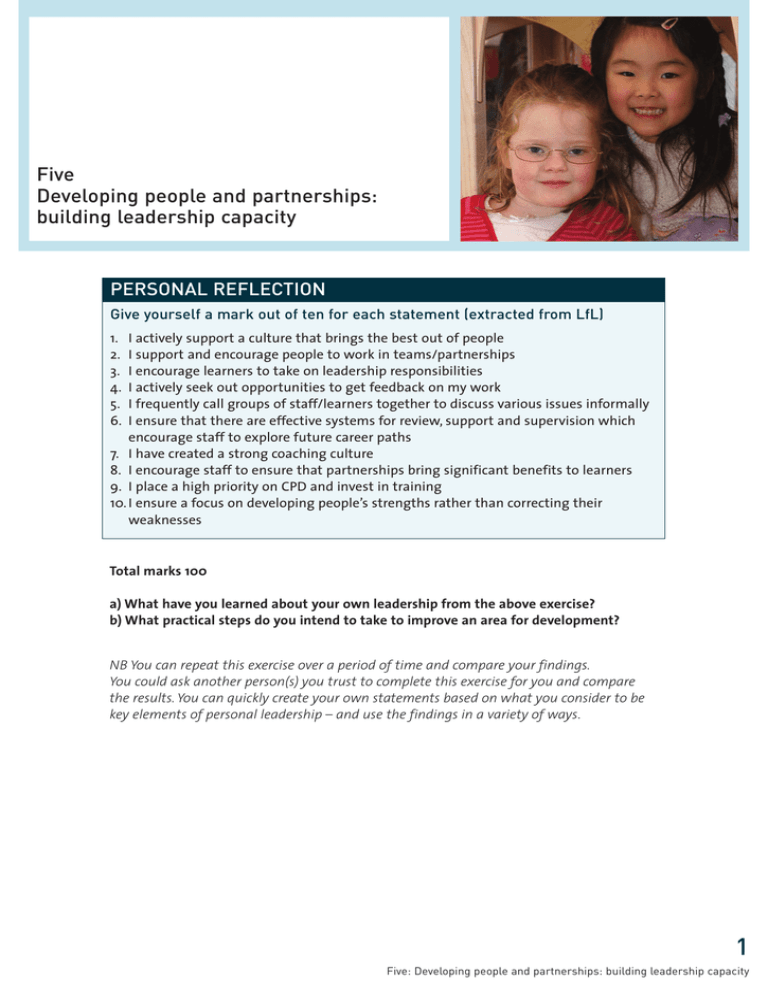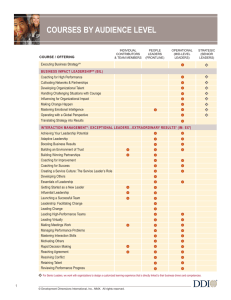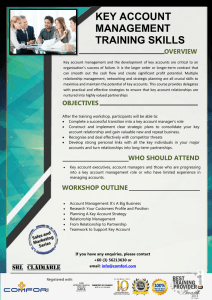Five Developing people and partnerships: building leadership capacity PERSONAL REFLECTION
advertisement

Five Developing people and partnerships: building leadership capacity PERSONAL REFLECTION Give yourself a mark out of ten for each statement (extracted from LfL) 1. 2. 3. 4. 5. 6. I actively support a culture that brings the best out of people I support and encourage people to work in teams/partnerships I encourage learners to take on leadership responsibilities I actively seek out opportunities to get feedback on my work I frequently call groups of staff/learners together to discuss various issues informally I ensure that there are effective systems for review, support and supervision which encourage staff to explore future career paths 7. I have created a strong coaching culture 8. I encourage staff to ensure that partnerships bring significant benefits to learners 9. I place a high priority on CPD and invest in training 10. I ensure a focus on developing people’s strengths rather than correcting their weaknesses Total marks 100 a) What have you learned about your own leadership from the above exercise? b) What practical steps do you intend to take to improve an area for development? NB You can repeat this exercise over a period of time and compare your findings. You could ask another person(s) you trust to complete this exercise for you and compare the results. You can quickly create your own statements based on what you consider to be key elements of personal leadership – and use the findings in a variety of ways. 1 Five: Developing people and partnerships: building leadership capacity CASE STUDY: Partnership and multi-agency working Partnerships vary enormously in size and remit and can be both formal and informal. Potentially, these partnerships are a very powerful way of achieving objectives that are beyond the scope of a single establishment working on its own. The best partnerships bring benefits to learners through joint improvement activities. Strong partnership working adds shared value to work in progress and is responsive to current and anticipated stakeholders’ needs, taking account of the local context. In order to make partnership most effective, it is important to invest time and resources in making them work well. The aims of the partnership and the responsibilities of each partner need to be clear. Suitable arrangements require to be in place which ensure co-ordination of action within the partnership and progress needs to be monitored regularly and reported. In best practice, partnership activities are managed through partnership agreements. (Reference LfL p72-73) The extract above is designed to help you think about your own context and to stimulate reflection, discussion and debate. QUESTIONS ■ Who do you consider to be your key partners/partnerships? How do you decide when a partnership is required? How do you decide when a partnership has finished its work? ■ Select one partnership (you could get groups to select different ones then share your findings) ■ What are the aims of the partnership? Why was it established? Who has responsibility for what? ■ What are the benefits which have resulted for individual learners and the establishment/service overall? ■ Who is responsible for monitoring and evaluating the partnership? Who decided this? ■ In what ways can the partnership be developed in order to bring about further benefits? ■ Are there other partnership possibilities? ■ How might these be pursued? 2 Five: Developing people and partnerships: building leadership capacity Five Developing people and partnerships: building leadership capacity CASE STUDY: Giving and receiving feedback Every member of staff is entitled to receive constructive feedback on how well they are taking forward their work and how they can improve their own performance further. Here is an example of giving and receiving feedback. The establishment has worked hard to establish a culture in which the giving and receiving of feedback is a normal part of working. Staff have taken part in CPD which has helped them to give and receive descriptive or non-judgemental feedback. This has been challenging at times because staff are so used to going quickly into evaluations. They have been coached to become aware of the difference between descriptive and evaluative feedback. Senior and middle managers are regularly out-and-about so that they know what is going on. They protect at least two days each week away from the office to see staff and students working. They go out of their way to ask for informal feedback from staff and students on any initiative that is underway. Whenever they observe staff and students working they ensure that they take time, before the end of that day, to have a brief, focused discussion with the member of staff concerned. Staff are released from timetabled sessions to observe each other working and to give and receive feedback. Staff record key points on a postcard. They are asked to give their views on the quality of leadership within the establishment as part of the self-evaluation process. All CPD events are evaluated and some are reviewed about six months later to see what difference it has made to working practices. The establishment also provides opportunities for staff to take on enhanced roles as part of their professional development. Unpromoted staff have chaired short life working parties. As a result of staff being asked to chair groups, a number requested training on effective group working. Staff report that they enjoy working and feel that they are part of a culture where their views are sought and listened to. (Reference LfL page This extract above is designed to help you think about your own context and to stimulate reflection, discussion and debate. QUESTIONS What are the essential components of a culture in which the giving and receiving of feedback is a normal part of working? ■ What is the difference between descriptive and evaluative feedback? Can you think of examples when both were used? When would you give evaluative feedback and why? ■ What techniques have you used that you find helpful when giving feedback? ■ Are those in leadership positions always willing to provide other staff with opportunities to feedback on the quality of leadership? ■ The above case study includes a number of contexts in which the giving and receiving of feedback takes place. Can you think of some more examples? ■ What has been the most useful feedback you have received? Why was it helpful? ■ What was the most damaging feedback you ever received? What impact did it have on you? What can you learn from this? ■ What practical steps might you take as the result of this exercise? ■ 3 Five: Developing people and partnerships: building leadership capacity Low WHERE ARE WE? High There is a lack of trust amongst staff, and between staff and learners in the establishment All relationships in our context are trusting, honest and respectful Within the establishment, there are few opportunities for staff to reflect on their practice, and there is little or no expectation that they will do so The process of self-evaluation and reflection is actively promoted and viewed as important within the establishment There is variation in the quality of teaching practice across the establishment There are clearly defended roles, responsibilities, expectations and protocols Staff consider their feelings and concerns go unheard or that they are misunderstood Colleagues have effective listening skills (non-judgemental acceptance, paraphrasing, summarising and clarifying) Learning conversations don’t take place During learning conversations, use of strategic questioning promotes reflection Feedback seems based on opinion, personal experience or hierarchy Feedback is thoughtful and is based on evidence and data Feedback is instructive Conversations create structures for collaborative problem solving No clear actions result from conversations Coaching conversations have clear and agreed outcomes REFLECTIONS: Developing a Coaching Culture (LfL p68) The development of a coaching /mentoring culture in establishments can make a significant contribution to the improvement of teaching and learning. The task overleaf provides an opportunity for individuals or groups of colleagues to reflect on the culture in their establishment with regard to coaching and mentoring. The statements range from “low” where there is a limited coaching culture, to “high” where the culture is positive. Reflect on the culture in your establishment using the continuum overleaf. Place “X” where you feel your establishment is on the continuum. Having reflected on where you are, consider: One thing you should start doing in order to promote a more positive coaching culture One thing you should keep doing And one thing you should stop doing 4 Five: Developing people and partnerships: building leadership capacity Five Developing people and partnerships: building leadership capacity CASE STUDY: Engaging young people in ‘project leadership’ Free Ears, West Lothian Free Ears is a project devised to highlight mental health issues. It helps young people to provide support in secondary schools. The main objectives of the project are to provide a safe place for young people to discuss issues that affect their everyday mental health and participate in activities that enable them to develop more positive coping mechanisms for crisis. CLD staff and a mental health link worker support the young people. Funding for the project came through the Scottish Executive Choose Life programme. During the summer a three-day film project was undertaken and the script writing and filming was led by young people with the support of a film project from Edinburgh. Issues dealt with included bullying, anxiety, stress and panic attacks. Through participation in this project young people were clearly able to evidence an increase in their confidence, self-esteem and team-working skills. Participants were clear that their engagement in this project had enabled them to voice their opinions, particularly in school, in a measured and appropriate way. The film was launched at an event in September 2006 and is used as a tool by professionals to increase their knowledge of mental health issues faced by young people. Young people took responsibility for the whole event, introduced the film and formed a question and answer panel afterwards. 70 people attended including teachers, social workers, mental health professionals and family and friends. The young people also delivered workshops at a national conference focused on mental health and young people. QUESTIONS ■ What would you consider to be the leadership benefits to young people from the work above? ■ What is happening in your area that helps to develop young people as learners in their community? ■ What are the best examples in your context of developing the leadership of learners? ■ What could you do to take this further? 5 Five: Developing people and partnerships: building leadership capacity Creating a coaching culture Increasingly, establishments are involved in coaching and mentoring developments. Some have arisen through the probationer programme, others through leadership projects. Looking at your own context take a minute to review the factors below which characterise a positive coaching culture. Provide clear examples where possible. ■ ■ ■ ■ ■ ■ ■ ■ ■ ■ ■ ■ ■ ■ The active support and involvement of senior staff in coaching and mentoring Individuals seek out opportunities to coach or mentor Individuals value being coached or mentored A structured programme of development is in place Clear linkage to establishments/authority improvement plan, PRD, professional standards Clear linkage to key learning and teaching strategies and outcomes for learners Time is made available to undertake the coach or mentor role Opportunities are given to review and share practice with other coaches or mentors There is ongoing review of the quality and impact of coaching and mentoring Conclusions from evaluations are used to inform further developments Collaborative work between coaches and mentors is evident Effective practice is identified, promoted, celebrated and shared There are regular opportunities for feedback Feedback is specific and focused on evidence QUESTIONS ■ What have you learned from this exercise? ■ What actions are you planning to take? 6 Five: Developing people and partnerships: building leadership capacity Recording sheet Tick Leaders matter: exerting influence and making a difference Vision, values and aims: sharing a common purpose Leadership and direction: focusing on what’s important Developing people and partnerships: building leadership capacity Leadership of change and improvement: achieving results Pathways for leaders SECTION Date Theme Key Points Arising Action Points




